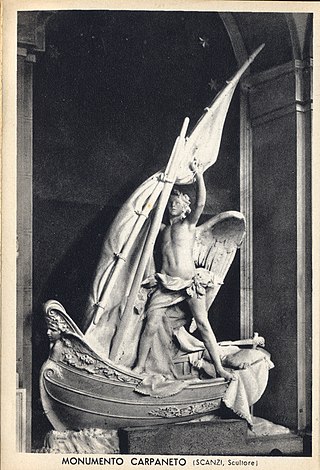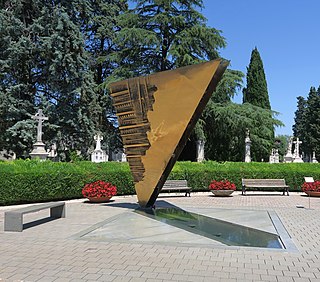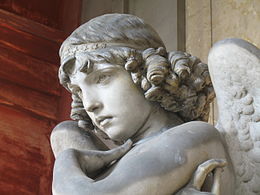
Giulio Monteverde was an Italian naturalist sculptor and teacher.

The Cimitero Monumentale is one of the two largest cemeteries in Milan, Italy, the other one being the Cimitero Maggiore. It is noted for the abundance of artistic tombs and monuments.

The Campo Verano is a cemetery in Rome, Italy, founded in the early 19th century. The monumental cemetery covers a surface area of 83 hectares which is currently divided into several sections: the main Catholic cemetery, the Jewish cemetery established in 1895, a Protestant section with its own entrance and a military section with monument to the victims of World War I.

The English Cemetery in Florence, Italy is an Evangelical cemetery located at Piazzale Donatello. Although its origins date to its foundation in 1827 by the Swiss Evangelical Reformed Church, the name "English Cemetery" results from the majority of its burials being Protestants from the British and American communities of Florence, and who gave the largest sum of money for the purchase of its land. The cemetery also holds the bodies of non-English speaking expatriates who died in Florence, among them Swiss and Scandinavians, as well as Eastern Orthodox Christians, among them Russians and Greeks. The cemetery is still owned by the Swiss Evangelical Reformed Church, and is open for the interment of cremated ashes, now of all Christian denominations, but no longer for burials.

Leonardo Bistolfi was an Italian sculptor and an important exponent of Italian Symbolism.

The Certosa di Bologna is a former Carthusian monastery in Bologna, northern Italy, which was founded in 1334 and suppressed in 1797. In 1801 it became the city's Monumental Cemetery which would be much praised by Byron and others. In 1869 an Etruscan necropolis, which had been in use from the sixth to the third centuries BC, was discovered here.

The Monumental Cemetery of Bonaria is located in Cagliari, Sardinia. In use between 1829 and 1968, this monumental cemetery originally occupied an area at the base of the hill of Bonaria, and over time expanded upwards. The main entrance is located in Piazza Cimitero, with a second entrance in Ravenna, at the Basilica of Bonaria. Several famous people were buried in Bonaria, including the canonical archaeologist Giovanni Spano, the tenor Piero Schiavazzi and General Carlo Sanna.

Augusto Rivalta was an Italian sculptor.

Tito Sarrocchi was an Italian sculptor.

Santo Varni was an Italian sculptor active mainly in Liguria.

The Monteverde Angel or Angel of the Resurrection is a masterpiece of neo-classical religious sculpture, created in marble in 1882 by the Italian artist Giulio Monteverde.
Luigi Fabris was an Italian sculptor and ceramist.

L'Angelo Nocchiero is a marble sculpture in the symbolist style by Genovese sculptor Giovanni Scanzi, completed in 1886. It was commissioned by Giacomo Carpaneto, Cav. Mauriziano (1811–1878) as a monument for his family tomb in the Monumental Cemetery of Staglieno in Genova, Italy. Along with the sculpture for the Oneto Family sculpted by Giulio Monteverde in 1882, the Carpaneto monument has become one of the most recognisable icons of Staglieno, appearing on an official cemetery brochure in 2014. Famous people of the 19th century visited Staglieno and commented on the work, which depicts an angel, standing astride a small boat, beginning to secure the sails at the end of a journey.

Vittorio Lavezzari (1864–1938) was an Italian sculptor from the Art Nouveau period, specializing in funerary sculpture. His sculptures can mostly be seen in Genoa in the Monumental Cemetery of Staglieno.
The Jewish monumental cemetery in Florence is a monumental cemetery on the current Ariosto avenue, just outside the ancient Renaissance walls, as it was not allowed to bury Jews in the city. It is open once a month, only on last Sundays, with two guided tours in the morning.

Giovanni Scanzi was an Italian sculptor. His early apprenticeship led to formal studies in Rome, followed by a career as a prolific artist and teacher. He was particularly active creating monuments for the Monumental Cemetery of Staglieno in Genoa, with many other works located in museums, churches and public venues in Genoa and elsewhere.

The Monumental Cemetery of Brescia is one of the first and most ancient monumental cemetery in Italy. It was the first construction project by the Neoclassical architect Rodolfo Vantini, who started its erection in 1813 and dedicated his whole life to its creation.
Bernard Pierre Wolff was a French-born American photographer. In the 1950s and 1960s he worked as an art director, and from the 1970s worked as a photographer travelling and taking photographs of people. He made street photographs in New York City in the 1970s. His photographs of monumental sculpture were used as cover artwork for music by Joy Division in 1980. All of his work is held by the Maison européenne de la photographie in Paris, which exhibited it in 2017.

The Monumental Cemetery of Mortara is located in the north-eastern outskirts of the city of Mortara, an Italian comune in the province of Pavia, in the region of Lombardy in northern Italy. The Monumental Cemetery of Mortara is one of the biggest and most important cemeteries in the Lomellina area.

The Monumental Cemetery of Rimini, also known as the Civic Cemetery of Rimini, is the main cemetery in the city of Rimini, in the region of Emilia-Romagna, northern Italy.



















